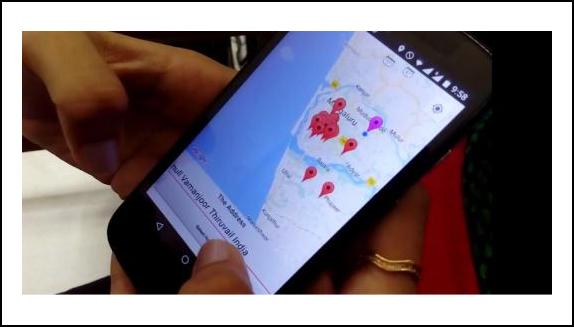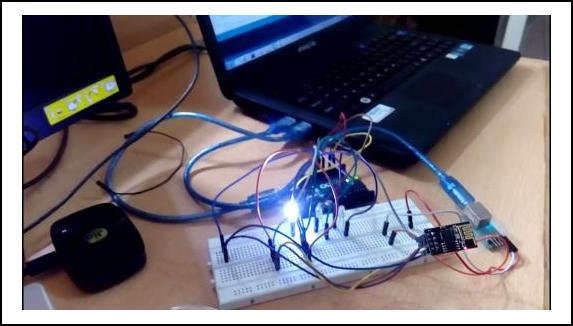-
Paper Information
- Next Paper
- Previous Paper
- Paper Submission
-
Journal Information
- About This Journal
- Editorial Board
- Current Issue
- Archive
- Author Guidelines
- Contact Us
International Journal of Internet of Things
2017; 6(2): 75-77
doi:10.5923/j.ijit.20170602.14

LISA (Life Saver)
Anusha A. Hegde, Ashish U. K., Hithakshi, Ms. Pramila M.
Computer Science and Engineering, St. Joseph Engineering College, Mangaluru, India
Correspondence to: Ashish U. K., Computer Science and Engineering, St. Joseph Engineering College, Mangaluru, India.
| Email: |  |
Copyright © 2017 Scientific & Academic Publishing. All Rights Reserved.
This work is licensed under the Creative Commons Attribution International License (CC BY).
http://creativecommons.org/licenses/by/4.0/

Increase in population on this planet has also increased the number of vehicles that travel on the roads. This resulted in more number of vehicles and has resulted in a heavy traffic in almost all the major cities and countries. The congestion in traffic has resulted in fatal vehicle accidents all over the world. Even after the existence of emergency services by the governments of all countries, the delay in the approaching of these services like ambulance due to the heavy traffics has been a major problem. The existing solutions that are already being implemented are traffic policing organization such as state traffic police or highway patrolling police. The other measures that are already being implemented are the sirens that are embedded with the emergency services vehicles so that the vehicles around them can create a clear passage to it. Primarily LISA has a feature that allows the ambulance driver to indicate the vehicles on the traffic at a radius of approximate 2 kilo meters and making sure of a clear lane on the road. The project LISA takes the source and destination coordinates of the ambulance driver and sends them to the server established which is present over the internet. This server in turn switches the LEDs present over the roads and indicates the vehicles in that range that an ambulance is coming their way and thus clearing a lane for the ambulance to pass without any traffic congestion. With LISA being implemented on the roads of a busy traffic, it is possible to curb the losses caused by the delayed services of emergency services.
Keywords: Arduino, Wifi Transciever, Webserver, JSON
Cite this paper: Anusha A. Hegde, Ashish U. K., Hithakshi, Ms. Pramila M., LISA (Life Saver), International Journal of Internet of Things, Vol. 6 No. 2, 2017, pp. 75-77. doi: 10.5923/j.ijit.20170602.14.
Article Outline
1. Introduction
- Traffic management is the severe problem of today's society because of urbanization. This cause traffic jams at the road junctions which in turn causes delay in ambulance response which in turn causes loss of life. Through this project we intend to design a system which eases the congestion faced by ambulance in heavy traffics. There are so many examples where ambulance get struck in traffic load, Ambulance has to wait for some minutes-hours to clear the traffic load. Patient may die because of lack of treatment at proper time. So this application reduces the time consumed by an ambulance to reach the hospital. This application is an android based tool that allows the ambulance to reach faster by dynamically controlling LEDs on the lane.
2. Objectives
- As a traffic controlling system, LISA’s main objective is to clear the traffic ahead of the ambulance by signaling the traffic over the road.O1: Authorized Access. Only authorized users can use the mobile application of LISA. This is made possible my issuing a Secret ID to the ambulance drivers who register with the admin with appropriate credentials.O2: Performance. Performance of LISA depends on the mobile phone used by the user, the internet connection availability and speed of the data services such as bandwidth.
3. Methodology
- The project LISA contains three platform which makes the project accomplish its goals. The LED lights which should be built over the roads are connected to a Arduino which switches the LEDs digitally. This Arduino takes the input from a WIFI Transceiver called as ESP8266. The mobile application built on Android platform sends the coordinates of the ambulance to the web server. The web server in turn sends the LED IDs associated with the location coordinates to the WIFI transceiver which switches the LEDs through the Arduino. LISA contains major 3 components such as the ambulance driver who uses the mobile phone application, the web server which guarantees data presence all over the network and the MicroController which is the reason to switch the LED lights on the road. Here the App is responsible for sending the co ordinates to the server which is built on PHP scripting and uses MySQL as data storage to pro-cess it. The MicroController executes the switching of LED lights according to the data sent by the server. The data from and app being the location co-ordinates is converted into JSON format which contains LED IDs. The IDEs used in this project are Arduino 1.8 IDE, Android Studio and a Web interface for PHP scripting.
 | Figure 1. Pictorial representation of LISA architecture |
4. Limitations and Future Work
- Limitations. This application runs on android version 3.0and above. This limits the market for this app. This application requires 3G internet connection so it may not work appropriately for lower data connections.Future Enhancements. The application is on its initial running stages. There are various improvements that can be implemented like GPS locations can be obtained from the hospital to the accident location. LISA being a project built over 3 platforms android, web and IOT requires more and more scenarios such as human behavior to the signals on road, to be studied so that LISA can give best out of it for the solution of traffic.
5. Conclusions
- Human life is very precious and must follow safety measures very consciously in all aspects. In this application, we use Global Positioning System (GPS) to avoid congestion of traffic to reach the life of its users. A simple mobile phone app which uses GPS by capturing the latitude and longitude of the ambulance vehicle and sends signal to the server, hence making uninterrupted traffic to the ambulance vehicle. This gives a solution for the problem of congestion in traffic for emergency vehicles without any interruption. Hence reduce the emergency response time.
 Abstract
Abstract Reference
Reference Full-Text PDF
Full-Text PDF Full-text HTML
Full-text HTML

